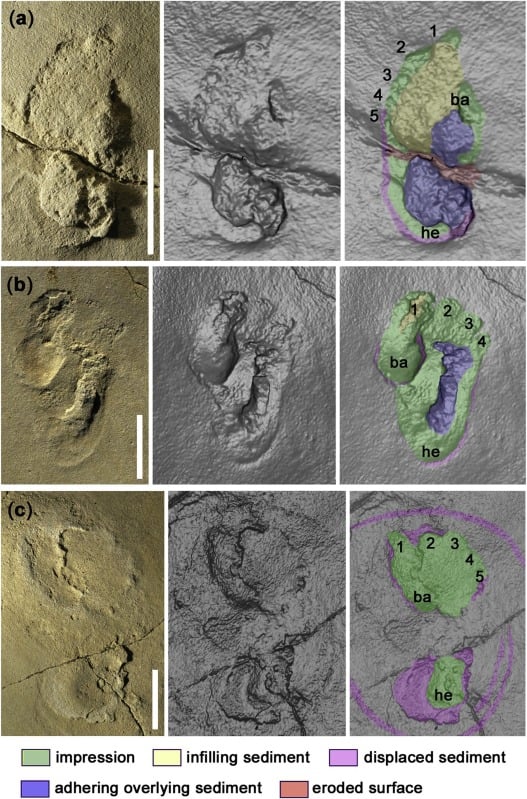
In 2002, researchers who had discovered hominid footprints on the Greek island of Crete discovered they were made an incredible 5.7 million years ago. Now, they say, they are putting back the date even further, making it almost certain that they are much older still.
Back in 2017, Dr. Per Ahlberg from Uppsala University and his colleagues determined that the footprints that had become fossilized in a rock on Crete were 5.7 million years old and made by a human ancestor.
This was a revolutionary finding, indicating that it was possible that humans evolved in Europe — launching a curveball into African-origin evolutionary theory. But recent research shows that the 50 footprints are more than 300,000 years older than previously thought, according to a scientific paper published in Scientific Reports.
The hominid, who had earlier been thought to belong to the group of proto-humans called Graecopithecus freyberg, who had been classified as such in 1944. Remains of this individual, affectionately named “El Graeco,” were found outside Athens.
Study co-author Uwe Kirscher, who is an expert on paleogeography at the University of Tübingen, said in a statement “The tracks are almost 2.5 million years older than the tracks attributed to Australopithecus afarensis (Lucy) from Laetoli in Tanzania.”
Crete footprints part of enduring mysteries of human evolution
Back in 2017, the original analysis of the footprints was mind-blowing enough, when Bournemouth University’s Matthew Robert Bennett and Ahlberg, an evolutionary biologist at Uppsala University, contended “The footprints are small tracks made by someone walking upright on two legs.”

These researchers, who also co-authored the scientific paper on the footprints, noted that the impressions on Crete “have a shape and form very similar to human tracks,” meaning there are five toes which do not have claws, as well as a parallel big toe and a ball of the foot, like Homo sapiens.
“Non-human ape footprints look very different,” the authors explain in the new paper. “(T)he foot is shaped more like a human hand, with the big toe attached low on the side of the sole and sticking out sideways.”
Using even more targeted dating techniques enabled the scientists to date the footprints even further back to the dawn of time, according to a report in Cosmos magazine. By testing foraminifera, the tiny fossilized marine microorganisms found in sedimentary rocks, they were able to arrive at a date of 6.05 million years ago.
Julien Louys, a Griffith University paleontologist who was not involved in the study, told Cosmos “Some of the footprints look like a bipedal animal, but a lot of the other footprints are very ambiguous and variable in size. Some of them don’t look like footprints at all. So, the issue here is making a very large claim on the basis of information that’s quite open to interpretation.”
The scientists who posited the original date are well aware that their findings might not jive with the mindset of other researchers, and they expected there would be doubters, saying “(Our) interpretation has been controversial, and several counter-interpretations have been made.”
Footprints found serendipitously while on vacation
The discoverer of these astounding footprints was not looking for hominid footprints from the prehistoric past. Paleontologist Gerhard Gierlinski, from Warsaw, Poland, was just trying to get away from it all in the summer of 2002 and enjoy the warm seas and soft sands on the Greek island of Crete with his girlfriend.
A researcher at the Polish Geological Institute, he was always ready to take samples of interesting things he spied on vacations, and he traveled with a hammer, a camera and a GPS for just such occasions.
The team of experts came to the conclusion that indeed, the impressions had been made by ancient human ancestors 5.7 million years ago, making them by far the oldest footprints ever discovered in Europe.
Earliest known hominid footprints in the world
They had been made during the Miocene era, at a time when the entire Mediterranean Sea had dried up. The scientific world was faced with the notion that these small footprints on the Greek island would now be the earliest-known human-like prints in the world — far older than the prints previously found in Africa, from Laetoli in Ethiopia, which were made 3.66 million years ago on a volcanic deposit there.
Once again, as they showed in 2017, these findings throw the previous paradigm of evolution into a spin, since the previously-held theory that has refined for decades now is that humans originated in one place only – Africa– and them migrated out from there.
The truth may be — as it often is — much more complicated than that, with hominins of different types evolving in different areas and migrating back and forth- especially as the Mediterranean was dried up for some time in the distant past.
The famous archaeologists the Leakey family discovered the fossils of what they called “Lucy” in Tanzania in 1974, leading many to believe that 3.2 million year ago evidence showed beyond a shadow of a doubt that humans evolved from that place and from that form only.
Lucy, a member of the Australopithecus afarensis family, left footprints that were at one time widely accepted as the very oldest pre-human body impressions. Still, even older body fossils that are believed to be those of early hominins have now been found in Africa, leading many to believe that Lucy may be only one piece of the puzzle and that human ancestors stretch back far beyond Lucy’s species and time.
Scientists believe that Homo sapiens, or modern humans, evolved into our present form approximately 300,000 years ago. All peoples living today who do not have an origin in Africa have genes from the now-extinct hominins known as Homo neanderthalensis, who were believed to have lived about 430,000 years ago.
So at some point it appears evident that the Mediterranean did indeed separate peoples from one another.
Still, as far back as 6.05 million years ago, there may have been the equivalent of an easily-traversed, broad plain or basin between what are now the separate continents of Europe and Africa.
“The interesting thing claimed in the new paper is that it demonstrates migration from Europe to Africa of these bipedal hominins,” Louys explains in the Cosmos article.
Intriguingly, this newest finding is consonant with “Desert Swing,” a theory that posits dry conditions in Mesopotamia and the Sahara sparked a mass migration of mammals from Eurasia to Africa a few hundred thousand years before these most ancient footprints, at 6.25 million years before the present, were made.
“All our studies of intercontinental migrations indicate that it’s not just a one-way street,” Louys says, adding “So even if we take at face value that these are hominin footprints, there’s no indication that they have to have originated in Europe and then moved to Africa, there’s equal possibility that they could have originated in Africa and moved to Europe.”
Six and a half years of “living hell”
After his first paper on the footprints was published in 2017, Ahlberg would describe what happened later as “six and a half years of sort of a living hell.” Their paper, published in the Proceedings of the Geologist Association, may be read by clicking here.
In an exclusive interview with Greek Reporter, Ahlberg was asked if there had been any further feedback — or blowback — since the 2017 publishing of the article, and if this discovery has been deliberately ignored and shunted aside since it may be politically incorrect or go against the “Africanist” theory of human origin.

“The short answer is that there has not been much of a response at all from the mainstream palaeoanthropological community.
“Of course you can never really know what goes on in the heads of other scientists, but I do rather think the story has been deliberately ignored because it doesn’t fit the prevailing narrative,” the member of the Swedish Academy of Sciences replies.
However, one key group of researchers, the scientist told Greek Reporter, have not ignored the startling findings of 2002.
“Shortly after publication, we made contact with Madelaine Böhme’s group at Tübingen and her colleagues in Bulgaria and Canada, who have been working on the scarce and fragmentary body fossil record of European Miocene hominins.
“The key animal on that side is Graecopithecus, known from a single lower jaw found near Athens, and a tooth plus some other bits and pieces from Bulgaria.
“It is similar in age to the Trachilos footprints, perhaps marginally older. As you might guess, the Böhme team had great difficulty getting their work published as well, and met the same kind of hostility as we did.”
These researchers were very impressed with the Trachilos team’s groundbreaking findings, and friendships were quickly established among the scientists.
Miocene-era ape lived in present-day Bulgaria
“Last spring we met up in Crete to film material for a major TV documentary dealing with the emerging evidence for an early presence of hominins in Europe, and also to take samples for palaeomagnetic dating and detrital zircon dating of the Trachilos locality,” Ahlberg recalls.
The documentary, called “Out of Europe: A New Story of Human Evolution?” can be viewed via this portal.
“The present dating, based on microfossils called foraminifera, is robust but not terribly precise; we would like to be able to narrow it down.
Now, it seems, that might have cemented their original theory even more.
Ahlberg says that team member David Begun, who’s based in Toronto, “has written a quite authoritative book about the Miocene apes of Europe called, delightfully, ‘The Real Planet of the Apes.’ This is getting quite a lot of attention. So while there are still plenty of people who are not listening, and who no doubt would like us to just shut up and go away, the debate is not in fact being shut down.”
“There are always people who are open-minded and curious enough to allow new perspectives to break through — though often only after a long struggle,” Ahlberg concludes.
“What is more of a concern is whether research funding in some areas is becoming strongly tied to adherence to particular paradigms, because that kind of thing can really stifle innovation. I have been extremely fortunate in having sufficient freely disposable funding to pursue ideas I’m interested in, even if they are unpopular with some.”
See all the latest news from Greece and the world at Greekreporter.com. Contact our newsroom to report an update or send your story, photos and videos. Follow GR on Google News and subscribe here to our daily email!



